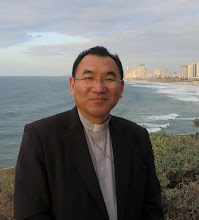Apr 10, 2011
Visit Sendai and Miyako
On Friday afternoon, a meeting was called in the office of Bishop Hiraga, Bishop of Sendai, to discuss about the plan to coordinate relief and rebuilding efforts of Sendai diocese. Since Bishops Conference had expressed their desire to support Sendai diocese for its effort to rebuild the diocese and appointed me as a coordinator, I have asked Bishop Hiraga to call the meeting among major players of the effort at this moment. Number of key persons attended the meeting including Bishop Tani of Saitama with his diocesan Caritas coordinator, staff members of Caritas Japan led by Fr. Narui, a team from Osaka diocese led by Fr. Kanda and Fr. Komatsu, the Sendai diocesan chancellor and the SG of the SDSC. A team from Osaka was invited because of their rich experience during the earthquake in 1995 and Fr. Kanda was one of the local leaders in relief and rehabilitation effort in Takatori area in Kobe. (Photo above: Miyako city destroyed)
During the meeting, Bishop Hiraga announced his policy of the reconstruction of the diocese which had two major points. First and most, the Sendai Diocese Support Center (SDSC) will continue to be the main activities of the diocese for relief and reconstruction. Secondly, he may assign his diocesan priests in coastal area to oversee relief and reconstruction activities and request other dioceses in Japan to send priests to support pastoral care of the inland area. In order to make formal request to other bishops, Bishop Hiraga will announce concrete plan very soon.
After the meeting, I traveled with Fr. Sakamoto of Niigata to Morioka. Usually it takes around 2 hours or more to reach Morioka from Sendai, but we spent more than 5 hours on Friday because of the yet another major earthquake on Thursday night. Because of the strong earthquake on Thursday, one of the strongest after the biggest one on 11 March, the Tohoku express way was damaged and part of it was closed. That was why we took much more time to travel. By the way, Cathedral main chapel was also affected by the earthquake on Thursday.
Then I visited Miyako on Saturday. Miyako is my hometown where I was born and baptised. At that time, my father was a catechist and mother was a teacher in the parish KG. The parish priest, Fr. Marco Antonio De La Rosa, MG, and Ms. Kato, the head teacher of the KG and my childhood friend, were waiting for us. On the day of the earthquake, Fr. Marco was in his hometown in Mexico and just returned a few days ago despite his friend's objection to go back to Japan because of the radiation crisis. The Miyako parish was not affected by tsunami. On the day of the earthquake, Ms. Kato had to take all her kids in the KG to near by mountain to take refuge in the Shinto shrine there. Then after the tsunami subsided, she had to look for a place to stay over night for these kids.
She took us to Taro where she lives with her family. As you know, Taro had been the most well protected town against Tsunami in Japan. Despite all the tall protection walls, majority of the town was completely washed away including Ms. Kato's house. Her family member was safe but had to look for a place of refuge in her friend's house. It was impossible to believe when I saw the town. There was nothing left for human habitation. Massive concrete walls are destroyed and scattered around in the bay. Ms. Kato told me that "the mother nature just wanted to go back to her origin so that she destroyed every man made structures. The wave could manage to destroy massive concrete structure into pieces but it did not do any harm to the famous San-no rock wall. The rock is just a high and slim wall standing in sea but nothing happened to that creature. So we may have to look into our life style. Maybe we are just doing something completely against to mother nature." It could be true. (Photo above: Taro town destroyed)
Subscribe to:
Post Comments (Atom)




No comments:
Post a Comment